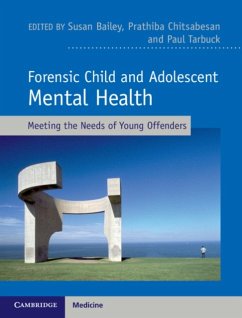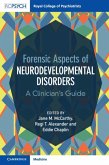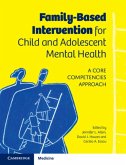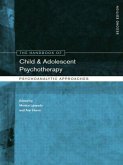Forensic Child and Adolescent Mental Health
Meeting the Needs of Young Offenders
Herausgeber: Bailey, Susan; Chitsabesan, Prathiba; Tarbuck, Paul
Schade – dieser Artikel ist leider ausverkauft. Sobald wir wissen, ob und wann der Artikel wieder verfügbar ist, informieren wir Sie an dieser Stelle.
Forensic Child and Adolescent Mental Health
Meeting the Needs of Young Offenders
Herausgeber: Bailey, Susan; Chitsabesan, Prathiba; Tarbuck, Paul
- Gebundenes Buch
- Merkliste
- Auf die Merkliste
- Bewerten Bewerten
- Teilen
- Produkt teilen
- Produkterinnerung
- Produkterinnerung
An overview of forensic child and adolescent mental health for professionals in mental health, social care, education, law and policy.
Andere Kunden interessierten sich auch für
![Forensic Aspects of Neurodevelopmental Disorders Forensic Aspects of Neurodevelopmental Disorders]() Forensic Aspects of Neurodevelopmental Disorders65,99 €
Forensic Aspects of Neurodevelopmental Disorders65,99 €![Family-Based Intervention for Child and Adolescent Mental Health Family-Based Intervention for Child and Adolescent Mental Health]() Family-Based Intervention for Child and Adolescent Mental Health52,99 €
Family-Based Intervention for Child and Adolescent Mental Health52,99 €![Mapping AIDS Mapping AIDS]() Lukas Engelmann (University of Edinburgh)Mapping AIDS40,99 €
Lukas Engelmann (University of Edinburgh)Mapping AIDS40,99 €![Studies in Forensic Biohistory Studies in Forensic Biohistory]() Studies in Forensic Biohistory88,99 €
Studies in Forensic Biohistory88,99 €![Studies in Forensic Biohistory Studies in Forensic Biohistory]() Studies in Forensic Biohistory48,99 €
Studies in Forensic Biohistory48,99 €![Understanding Forensic DNA Understanding Forensic DNA]() Suzanne Bell (West Virginia University)Understanding Forensic DNA12,99 €
Suzanne Bell (West Virginia University)Understanding Forensic DNA12,99 €![The Handbook of Child and Adolescent Psychotherapy The Handbook of Child and Adolescent Psychotherapy]() The Handbook of Child and Adolescent Psychotherapy59,99 €
The Handbook of Child and Adolescent Psychotherapy59,99 €-
-
-
An overview of forensic child and adolescent mental health for professionals in mental health, social care, education, law and policy.
Produktdetails
- Produktdetails
- Verlag: Cambridge University Press
- Seitenzahl: 346
- Erscheinungstermin: 24. April 2017
- Englisch
- Abmessung: 258mm x 194mm x 24mm
- Gewicht: 904g
- ISBN-13: 9781107003644
- ISBN-10: 1107003644
- Artikelnr.: 48208586
- Herstellerkennzeichnung
- Libri GmbH
- Europaallee 1
- 36244 Bad Hersfeld
- gpsr@libri.de
- Verlag: Cambridge University Press
- Seitenzahl: 346
- Erscheinungstermin: 24. April 2017
- Englisch
- Abmessung: 258mm x 194mm x 24mm
- Gewicht: 904g
- ISBN-13: 9781107003644
- ISBN-10: 1107003644
- Artikelnr.: 48208586
- Herstellerkennzeichnung
- Libri GmbH
- Europaallee 1
- 36244 Bad Hersfeld
- gpsr@libri.de
List of contributors; Preface; 1. The nature of adolescence Mary Shooter
and Mike Shooter; 2. Origins of adolescent offending Barbara Maughan; 3.
Psychosocial resilience, psychosocial care and forensic mental healthcare
Verity Kemp and Richard Williams; 4. Assessment of young offenders: mental
health, physical, educational and social needs Prathiba Chitsabesan and
Lorraine Khan; 5. Risk assessment and management with adolescents Charlotte
Lennox and James Millington; 6. The influence of neurodevelopmental
impairment on youth crime Prathiba Chitsabesan, Nathan Hughes and Hugh
Williams; 7. Serious offences - origins and nature of individual violence
Charlotte Lennox and Rajan Nathan; 8. Childhood predictors of young
homicide offenders and victims and their implications for interventions Lia
Ahonen, David Farrington, Rolf Loeber, Dustin Pardini and Rebecca
Stallings; 9. Group violence and youth gangs Lorraine Khan, Heather Law and
Sally Zlotowitz; 10. Young people with harmful sexual behaviours Simon
Hackett, Maeve Murphy and Kenny Ross; 11. Depression and self-harm and
suicidal behaviour in young offenders Heidi Hales, Justine Rothwell and
Gemma Trainor; 12. Post-traumatic stress disorder and complex trauma in
young people at risk of entering the criminal justice system Shreeta Raja
and Andrew Rogers; 13. Young people with schizophrenia in forensic settings
Enys Delmage; 14. Substance misuse in young people with antisocial
behaviour Sam Cox and Louise Theodosiou; 15. Attention deficit
hyperactivity disorder and antisocial behaviour Ben Greer, Oliver White and
Susan Young; 16. Autistic spectrum disorders in young people in the
criminal justice system Gillian Baird and Ernest Gralton; 17. Youth
psychopathy Elaine Johnstone; 18. Treatment and management: early
interventions in conduct disorder and oppositional defiant disorder Justine
Ifield, Stephen Scott and Leena K. Augimeri; 19. Cognitive, behavioural and
related approaches in young offenders Paul Mitchell and Charlotte
Staniforth; 20. Systemic treatment approaches in young people with risky
behaviours Simone Fox and Helen Jones; 21. Sounding the picture - drawing
out the sound: music therapy and art therapy with young people who have
committed serious criminal offences Lynn Aulich and Joanna Holroyd; 22.
Children and the law Enys Delmage, Mike Shaw and Hannele Variend; 23. Youth
justice services in England and Wales Paul Tarbuck; 24. Working with young
people in a secure environment Pam Hibbert, Paul Mitchell and Jim Rose;
Index.
and Mike Shooter; 2. Origins of adolescent offending Barbara Maughan; 3.
Psychosocial resilience, psychosocial care and forensic mental healthcare
Verity Kemp and Richard Williams; 4. Assessment of young offenders: mental
health, physical, educational and social needs Prathiba Chitsabesan and
Lorraine Khan; 5. Risk assessment and management with adolescents Charlotte
Lennox and James Millington; 6. The influence of neurodevelopmental
impairment on youth crime Prathiba Chitsabesan, Nathan Hughes and Hugh
Williams; 7. Serious offences - origins and nature of individual violence
Charlotte Lennox and Rajan Nathan; 8. Childhood predictors of young
homicide offenders and victims and their implications for interventions Lia
Ahonen, David Farrington, Rolf Loeber, Dustin Pardini and Rebecca
Stallings; 9. Group violence and youth gangs Lorraine Khan, Heather Law and
Sally Zlotowitz; 10. Young people with harmful sexual behaviours Simon
Hackett, Maeve Murphy and Kenny Ross; 11. Depression and self-harm and
suicidal behaviour in young offenders Heidi Hales, Justine Rothwell and
Gemma Trainor; 12. Post-traumatic stress disorder and complex trauma in
young people at risk of entering the criminal justice system Shreeta Raja
and Andrew Rogers; 13. Young people with schizophrenia in forensic settings
Enys Delmage; 14. Substance misuse in young people with antisocial
behaviour Sam Cox and Louise Theodosiou; 15. Attention deficit
hyperactivity disorder and antisocial behaviour Ben Greer, Oliver White and
Susan Young; 16. Autistic spectrum disorders in young people in the
criminal justice system Gillian Baird and Ernest Gralton; 17. Youth
psychopathy Elaine Johnstone; 18. Treatment and management: early
interventions in conduct disorder and oppositional defiant disorder Justine
Ifield, Stephen Scott and Leena K. Augimeri; 19. Cognitive, behavioural and
related approaches in young offenders Paul Mitchell and Charlotte
Staniforth; 20. Systemic treatment approaches in young people with risky
behaviours Simone Fox and Helen Jones; 21. Sounding the picture - drawing
out the sound: music therapy and art therapy with young people who have
committed serious criminal offences Lynn Aulich and Joanna Holroyd; 22.
Children and the law Enys Delmage, Mike Shaw and Hannele Variend; 23. Youth
justice services in England and Wales Paul Tarbuck; 24. Working with young
people in a secure environment Pam Hibbert, Paul Mitchell and Jim Rose;
Index.
List of contributors; Preface; 1. The nature of adolescence Mary Shooter
and Mike Shooter; 2. Origins of adolescent offending Barbara Maughan; 3.
Psychosocial resilience, psychosocial care and forensic mental healthcare
Verity Kemp and Richard Williams; 4. Assessment of young offenders: mental
health, physical, educational and social needs Prathiba Chitsabesan and
Lorraine Khan; 5. Risk assessment and management with adolescents Charlotte
Lennox and James Millington; 6. The influence of neurodevelopmental
impairment on youth crime Prathiba Chitsabesan, Nathan Hughes and Hugh
Williams; 7. Serious offences - origins and nature of individual violence
Charlotte Lennox and Rajan Nathan; 8. Childhood predictors of young
homicide offenders and victims and their implications for interventions Lia
Ahonen, David Farrington, Rolf Loeber, Dustin Pardini and Rebecca
Stallings; 9. Group violence and youth gangs Lorraine Khan, Heather Law and
Sally Zlotowitz; 10. Young people with harmful sexual behaviours Simon
Hackett, Maeve Murphy and Kenny Ross; 11. Depression and self-harm and
suicidal behaviour in young offenders Heidi Hales, Justine Rothwell and
Gemma Trainor; 12. Post-traumatic stress disorder and complex trauma in
young people at risk of entering the criminal justice system Shreeta Raja
and Andrew Rogers; 13. Young people with schizophrenia in forensic settings
Enys Delmage; 14. Substance misuse in young people with antisocial
behaviour Sam Cox and Louise Theodosiou; 15. Attention deficit
hyperactivity disorder and antisocial behaviour Ben Greer, Oliver White and
Susan Young; 16. Autistic spectrum disorders in young people in the
criminal justice system Gillian Baird and Ernest Gralton; 17. Youth
psychopathy Elaine Johnstone; 18. Treatment and management: early
interventions in conduct disorder and oppositional defiant disorder Justine
Ifield, Stephen Scott and Leena K. Augimeri; 19. Cognitive, behavioural and
related approaches in young offenders Paul Mitchell and Charlotte
Staniforth; 20. Systemic treatment approaches in young people with risky
behaviours Simone Fox and Helen Jones; 21. Sounding the picture - drawing
out the sound: music therapy and art therapy with young people who have
committed serious criminal offences Lynn Aulich and Joanna Holroyd; 22.
Children and the law Enys Delmage, Mike Shaw and Hannele Variend; 23. Youth
justice services in England and Wales Paul Tarbuck; 24. Working with young
people in a secure environment Pam Hibbert, Paul Mitchell and Jim Rose;
Index.
and Mike Shooter; 2. Origins of adolescent offending Barbara Maughan; 3.
Psychosocial resilience, psychosocial care and forensic mental healthcare
Verity Kemp and Richard Williams; 4. Assessment of young offenders: mental
health, physical, educational and social needs Prathiba Chitsabesan and
Lorraine Khan; 5. Risk assessment and management with adolescents Charlotte
Lennox and James Millington; 6. The influence of neurodevelopmental
impairment on youth crime Prathiba Chitsabesan, Nathan Hughes and Hugh
Williams; 7. Serious offences - origins and nature of individual violence
Charlotte Lennox and Rajan Nathan; 8. Childhood predictors of young
homicide offenders and victims and their implications for interventions Lia
Ahonen, David Farrington, Rolf Loeber, Dustin Pardini and Rebecca
Stallings; 9. Group violence and youth gangs Lorraine Khan, Heather Law and
Sally Zlotowitz; 10. Young people with harmful sexual behaviours Simon
Hackett, Maeve Murphy and Kenny Ross; 11. Depression and self-harm and
suicidal behaviour in young offenders Heidi Hales, Justine Rothwell and
Gemma Trainor; 12. Post-traumatic stress disorder and complex trauma in
young people at risk of entering the criminal justice system Shreeta Raja
and Andrew Rogers; 13. Young people with schizophrenia in forensic settings
Enys Delmage; 14. Substance misuse in young people with antisocial
behaviour Sam Cox and Louise Theodosiou; 15. Attention deficit
hyperactivity disorder and antisocial behaviour Ben Greer, Oliver White and
Susan Young; 16. Autistic spectrum disorders in young people in the
criminal justice system Gillian Baird and Ernest Gralton; 17. Youth
psychopathy Elaine Johnstone; 18. Treatment and management: early
interventions in conduct disorder and oppositional defiant disorder Justine
Ifield, Stephen Scott and Leena K. Augimeri; 19. Cognitive, behavioural and
related approaches in young offenders Paul Mitchell and Charlotte
Staniforth; 20. Systemic treatment approaches in young people with risky
behaviours Simone Fox and Helen Jones; 21. Sounding the picture - drawing
out the sound: music therapy and art therapy with young people who have
committed serious criminal offences Lynn Aulich and Joanna Holroyd; 22.
Children and the law Enys Delmage, Mike Shaw and Hannele Variend; 23. Youth
justice services in England and Wales Paul Tarbuck; 24. Working with young
people in a secure environment Pam Hibbert, Paul Mitchell and Jim Rose;
Index.








